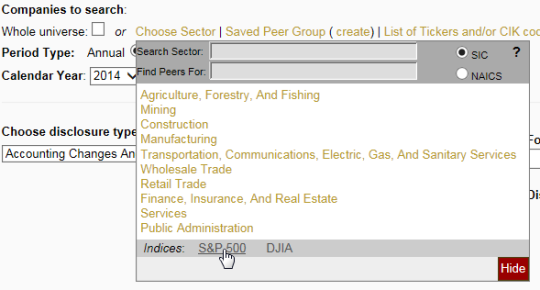Acquisitions are a very common part of the business landscape. Some work out well, others not as well. Predicting which will be which is more of an art than a science. But you can (and should) use hard data to at least determine what is your downside risk as an investor in the case the deal goes south.
On Calcbench, we do this using our newest feature…fully interactive disclosures that link each number in the text with its corresponding detailed XBRL info. The power of this is it allows us to trace any of our standardized metrics back to its source text in the ‘paper document’.

We’ll start by going to our Interactive Footnote Viewer (https://www.calcbench.com/footnote/) and pick a list of companies to look at: the S&P 500 for example.

Next, choose the topic we’re interested in: business combinations. In particular, we’ll look at the goodwill ‘created’ when companies buy other companies. (Goodwill in accounting terms is the amount paid for a company above and beyond the actual assets of that company). There is goodwill resulting from most every acquisition. However, large goodwill numbers can be a red flag, because they may lead to large write-downs if the acquisition doesn’t work out as hoped. (Potential example here pertaining to Microsoft’s purchase of Nokia)
Choose the metric using our explorer:

Now, let’s go through the S&P 500 and see what we can find. Choose the “Portion of Purchase Price Allocated to Goodwill” metric, and our list will come up.

Aha! Without going very far at all, here’s a case where goodwill is over $1 billion, and over 50% of the purchase price. Now it is up to the analyst to decide if this is a risk or not. But it is certainly something to consider in analyzing this company. If this acquisition does end up falling short of expectations, you can expect some of this goodwill to disappear, which will take earnings down with it.